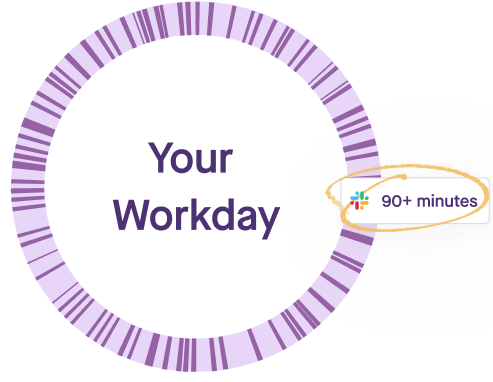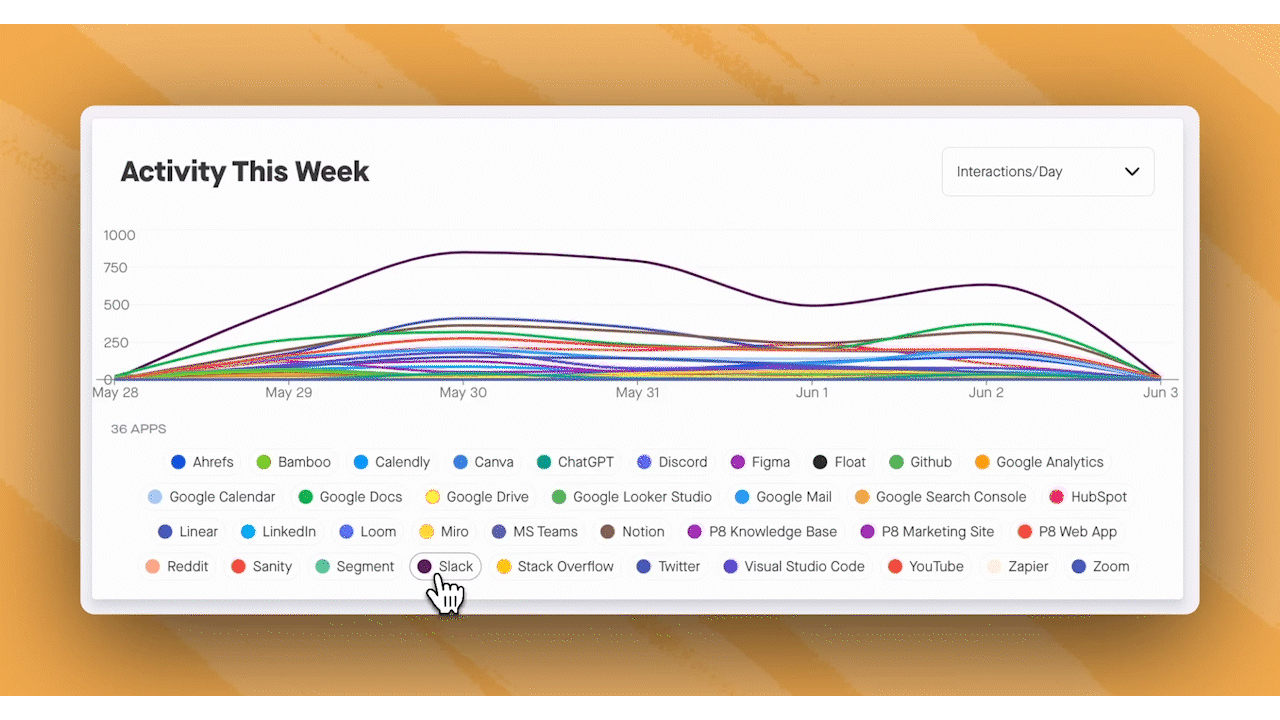Produce8
MSPs looking for the Produce8 Playbook, look no further!
How to Use Slack Better: A Guide to Team Collaboration and Concentration
Reclaiming productivity and focused work for your team
When thinking about productivity, leaders tend to have several hypotheses as to what might be getting in the way. However, we can all agree that the results should look the same:
- Tasks getting done on time
- Team goals being accomplished
- Space for focused work to increase quality and reduce chances of error
- A healthy and engaged workforce
What if we told you that the hidden wolf in your organization might be one of your most beloved tools?
Slack.
We are big fans of Slack. Our team relies on it daily, and we're confident that yours does too. Slack is one of the most popular communication and collaboration tools in the world today. According to Demand Sage , Slack will have 47.2 million daily active users and 79 million monthly active users by 2025.

However, alongside its numerous communication advantages, Slack also poses distractions that impact workplace productivity and focus.
So, how much time do we spend collaborating on Slack, how much is noise, and how much is distraction? Is the tool secretly blocking your team’s potential? We know it is.
Whether you've pinpointed your productivity issues or still figuring them out, reassessing your workflows shows proactiveness.
In this guide, you’ll learn:
- How Slack is occupying your team's time and energy
- Strategies to reclaim productivity in a world of constant connectivity and burnout
- Questions to gauge the problem's impact on your team
- How to use hard data to create lasting, scalable changes
And you’ll get free access to the Produce8 + Slack Playbook, our how-to guide on how to maintain the best aspects of Slack without fostering a culture of distraction.

1. The hidden costs of Slack
According to a 2020 report in Wired , Slack has been labeled a "scary offender" by neuroscientist and lecturer Lucas Miller. Why? Because of its constant distractions, which hinder people from effectively completing their work.
There are many resources that state that Slack and the way we use it are costing you and your team valuable time in the workday.
Context switching – the killer of productivity
Slack's notifications disrupt work, leading teams to frequently address messages and switch between tasks. This increases the time required to complete each assignment. Research from the University of California, Irvine and Humboldt University showed that people can lose up to 23 minutes on a task every time they are interrupted . Think about how much that could cost an entire team!
If a team gets interrupted at least 5 times while working on an important task, their ability to complete their work would be delayed by approximately 2 hours.
Lack of prioritization
Do you often get the sense that every request is “urgent”? The need to be connected and available at all times for “important” requests opens windows for interruptions. Moreover, science proves that when dealing with complex assignments like strategizing or creating, the brain focuses on tasks that seem more manageable . Checking and responding to Slack is an easy task that gives workers a sense of achievement. After all, it doesn’t require the same amount of mental energy as their primary work.
This leads to critical projects often getting delayed, a sense of constant cramming, and a burned-out workforce that is always working but not getting core tasks done.
Bottom line: there’s less space for deep work
Deep work is the ability to concentrate on challenging tasks—like researching, strategizing, or creating a thoughtful piece of content—without distractions. However, Slack's frequent interruptions can greatly impede the opportunity for deep work.
2. Reclaiming time in the digital age
Now that we have identified the core business areas that Slack is blocking, we can agree that creating space for great work is fundamental to achieving our goals.
But that can’t happen if our work environment does not foster a space for breaks, focused work, and getting tasks done without overtime.
Given the considerable time teams devote to Slack and its addictive qualities, it is unsurprising that digital workers find it challenging to prioritize tasks and stay abreast of changes. Leaders often jump from one trendy productivity hack to another, hoping they can solve the problem. However, they rarely see the changes they want to see because they failed to define the problem in the first place. The truth is that the leader or the individual worker alone cannot solve the problem—and often the tips, hacks, and quick fixes out there simply won’t work.
3. Assessing the size of the problem
Slack's persistent notifications, instant gratification through immediate responses and reactions, and allure of "unread messages" collectively contribute to an addictive user experience and frequent context-switching. By seamlessly blending work and social dynamics, Slack taps into our inherent need for social validation, prompting us to constantly check for updates.
Teams lose sight of their primary objectives amidst constant pins and notifications.
These noises infiltrate the work environment, fragmenting focus and hindering deep work. A relentless stream of messages fosters a culture where immediate response and availability become the norm, leading to work that extends far beyond the standard eight hours. The result? Burnout, diminished work-life balance, and a compromised sense of well-being.
Slack fosters a culture where immediate response and availability become the norm, leading to a compromised sense of well-being.

If you and your team weren’t able to answer all these questions, you’re not alone. They can’t be answered unless we can visualize the problem with the right data.
Where Do We Want to Be?
Imagine an environment where our teams can truly focus, collaborate efficiently, and achieve meaningful results. Picture a workplace that values uninterrupted work time and empowers employees to leverage the best aspects of Slack. By defining our vision, we pave the way for a transformation that will benefit the whole team.
The Illusion of Slack Hacks and Guidelines
Many organizations attempt to address the Slack dilemma through hacks, best practices, and guidelines. However, these efforts often fall short. Even Slack's built-in analytics provide only a glimpse of the overall picture.
Without comprehensive data, measuring the true impact of Slack guidelines and policies is nearly impossible.
The absence of tangible metrics—such as the number of interactions, time spent on the platform, and the actual extent of focused work—leaves organizations and their teams blind to the magnitude of the problem.
4. Decoding organizational changes through hard data
To break free from Slack-induced distractions, we must embrace a data-driven approach. By using comprehensive analytics that measure the intensity of interruptions, visualize focused work periods, and promote muting options during critical tasks, organizations gain the insights needed to make impactful changes. These changes can be customized to fit the specific needs of teams.
You can continue collaborating while reducing distractions and context-switching.
Produce8 is a digital work analytics platform that gives the whole team the window to see inside Slack and understand exactly how collaborations and distractions occur.
We help you visualize how Slack is getting in the way of your team’s work and offer the right visualization and context to study the data. Produce8 connects to Slack and analyzes interactions and time spent on the tool. In this way, you can understand the problem from an organizational, departmental, and team perspective.

The time to address the Slack distraction dilemma is now. It is crucial to recognize the addictive nature of Slack, the associated costs to productivity and work-life balance, and the limitations of existing guidelines and practices. Embracing data-driven insights and cultivating a culture of curiosity will enable organizations to make informed decisions, implement effective changes, and reclaim their teams' attention, time, and well-being. It's time to escape the interruption machine and forge a path toward a more productive and balanced work environment.
The urgency to solve the problem lies in your hands. Don't let Slack's hidden costs hinder your team's ability to achieve their full potential. Take the next step with Produce8!
Your next move:
The Produce8 + Slack Playbook
Before you go, let’s revisit what we presented in this guide.
The problems with digital work:
- We must prioritize focus more, as it enables us to develop creative, insightful, and meaningful work.
- However, our ability to concentrate and be productive is declining.
- Workers are working longer hours and reporting higher levels of burnout.
How do we solve this? We have found that the main contributors are not the people, but the addictive and distracting tools they use for collaboration, which compel them to constantly switch between tasks.
Since the primary concern with messaging tools is not the duration of their usage, but rather the frequency with which we are drawn into them…
We created a free playbook to help you head in the right direction. Once and for all.
What the Produce8 + Slack Playbook will help you accomplish
Our goal here is simple: We want to help you decrease the number of interactions (i.e. distractions) on Slack per day.
With our Playbook, you can reduce your team’s average daily Slack interactions by 33%. The payoff: 30 minutes of time recovered per person per day
To learn more, check out the Produce8 + Slack Playbook for free. No signup or email required. The problem is so common and so urgent for teams like yours that we’ve decided to bring down the walls.
Related Aritcles
Digital Work Analytics reporting
AIRO Part 4 - From Reactive IT to Managed AI - The Next Evolution for MSPs
2 min read
Unlock great workdays
Wether you are collaborating with your team or solo tackling your day we can help you recover the most valuable asset, time.
